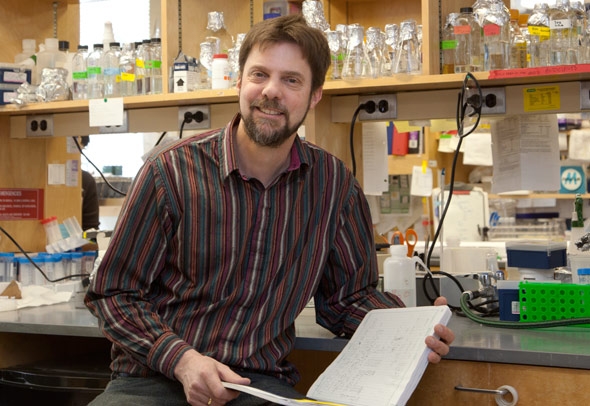Dartmouth researchers were awarded $8.9 million during November 2010, including $5.4 million in new and competing awards. View the complete list of awards, as reported by the Office of Sponsored Projects. Here, Dartmouth Now spotlights three investigators and their work.
Alan Gustman, Loren M. Berry Professor of EconomicsNational Bureau of Economic Research Integrating Models of Health and Retirement

Alan Gustman’s research helps policy makers understand the effects of financial incentives on retirement behavior. (photo by Joseph Mehling ’69)
Cause and effect: Gustman’s project involves exploring the detailed roles of health outcomes in an econometric model of retirement and saving that he has developed with Tom Steinmeier of Texas Tech University. The model is designed to help researchers and policy makers understand the effects of financial incentives created by various features of pension plans, Social Security rules, earnings opportunities in the labor market for full-time and part-time work, and market returns to saving. The model also distinguishes the effects of such financial incentives from the effects of preferences (for example, willingness to save), family structure, and health. A second part of their project builds on their decades of work as part of a team that developed the Health and Retirement Study, which Gustman calls “the most important single data set for analyzing health, retirement, and wealth available for the U.S. population.”
Innovations and outcomes: “We have been able to help policy makers understand how current program rules affect retirement and saving,” Gustman says, “and more importantly, how new innovations in retirement programs, such as changing the Social Security retirement age, would affect outcomes.”
Teamwork: Gustman’s collaborators also include Nahid Tabatabai, a research economist in Dartmouth’s Department of Economics. His research has been supported by the National Institutes of Health and the Social Security Administration. It has involved cooperation between the National Bureau of Economic Research, the Michigan Retirement Research Center, the Rand Corporation, the Health and Retirement Survey, and Dartmouth.
Stephanie Miller, program director, New Hampshire Birth Conditions Program, Dartmouth Medical School Department of PediatricsUniversity of New Hampshire Development and Initiation of a New England Birth Defects Consortium

Stephanie Miller oversees a consortium of six New England states’ birth defect registry programs. (photo by Joseph Mehling ’69)
Sharing information: The New England Birth Defects Consortium (NEBDC) is a regional collaboration with the shared mission of improving services for infants and children in New England who have birth defects. Begun in 2009, the consortium facilitates project coordination among six New England birth defect registry programs. The consortium received early support from the New England Genetics Collaborative.
Ounce of prevention: In January 2011, the NEBDC began a 12-month pilot project that provides multivitamins containing folic acid and one-on-one education to women of childbearing age for the prevention of birth defects. The pilot launched simultaneously in all six consortium states. “This is the largest standardized prevention project conducted to date among all birth defects surveillance programs in the United States,” Miller says.
Teamwork: As program director for the New Hampshire Birth Conditions Program, Miller collaborates with Dr. Margaret Karagas at the Children’s Environmental Health and Disease Prevention Center. Through the NEBDC, she works with directors of birth defects programs in Maine, Vermont, Massachusetts, Connecticut and Rhode Island.
G. Eric Schaller, professor of biological sciencesUniversity of North Carolina at Chapel Hill Arabidopsis 2010: Analysis of the Cytokinin-regulated Transcriptional Network

Eric Schaller studies hormones that regulate an array of growth and developmental processes in agriculturally important plants. (photo by Joseph Mehling ’69)
Green growth: Schaller explains that cytokinins are plant hormones that regulate an array of plant growth and developmental processes, including the control of greening and branching, that are significant to agriculture.
Gene expression: “Many of the effects of cytokinin are controlled through gene expression,” Schaller says. “Our goal is to define this network of cytokinin-regulated gene expression by using molecular, genetic, and computational approaches. The identification of key players in this network will provide avenues by which scientists can modify agriculturally important traits.”
Teamwork: Schaller collaborates with Joe Kieber at the University of North Carolina–Chapel Hill, Ann Loraine at the University of North Carolina–Charlotte, and Dennis Mathews at the University of New Hampshire. As part of the grant, which originates with the National Science Foundation, they also partner with the Montshire Museum of Science in Norwich, Vt., to maintain and expand on “Experimenting with Plants,” an experimental biology program for middle school students in Vermont and New Hampshire.
